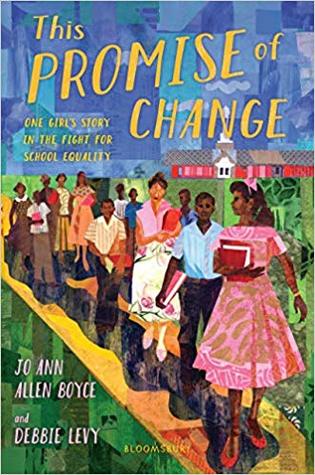
This Promise of Change: One Girl’s Story in the Fight for School Equality
Written by Jo Ann Allen Boyce and Debbie Levy
Bloomsbury Children’s Books, 2019, 310pp
ISBN: 978-1-68119-852-1
In 1956, author Jo Ann Allen Boyce was one of twelve courageous students (and families) who integrated Clinton High School in Tennessee. The Brown v. Board of Education Supreme Court decision (1954) outlawed segregation in U.S. public schools. In January, 1956, Robert L. Taylor, a federal district judge in Tennessee, ruled that all-white Clinton High School must admit African American students. In the fall of 1956, Jo Ann was one of the students known as the “Clinton 12.”
In this memoir in verse, Boyce retells the experience of having integrated her high school. The poems in this book are written in the voice of her teenage self. Her recollection and emotions ring true. She recalls the pride and hope she felt on the first days of school. “I can’t help feeling prideful / (though pride caused many to fall) / to know I am one of twelve / to break this racial wall” (p. 71). She also shares the fear she had to overcome after an outside agitator fomented violence and the Ku Klux Klan burned crosses on lawns in her small town.
The support from family, fellow African American students and friends, and faith are evident throughout the book. The African American community in Clinton lived on a hill above the town. In the poem, “Down the Hill,” Boyce shares her compassion for her mother. “To see me play the hand that we were dealt, / grim games with rules that change from day to day. / I felt it too, the dread, the hurt, the fear / of walking down our Hill to face the crowd” (p. 253). She also clearly conveys racially motivated violence, the bravery of a white pastor who escorted the students to school, the commitment of the school principal and some Clinton High teachers to uphold the law, and the indifference of the town mayor. “Lukewarm. / But law-abiding. / That puts Mayor Lewallen on our side. / With friends who call you ‘a bitter dose,’ / who needs enemies?” (p. 135).
After receiving death threats, Boyce’s father moved their family to California after the 1956 fall semester. The author states, “Hatred leaves holes in the heart, a scarred mind, and a wasted brain—and I am speaking of its effects on those who hold this disease in their hearts and inflict it on others” (p. 272). Six of the twelve Clinton African American students remained in school until the end of that school year. Her friend Bobby Cain was the first African American male to graduate from an integrated state high school in Tennessee (1957), and Gail Ann Upton Epps, her best friend, was the first African American female graduate from Clinton (1958).
The book includes a scrapbook of primary source photographs from various sources including the author’s own collection and The Life Picture Collection/Getty Images. It also includes a timeline of school desegregation and civil rights landmarks, quotation sources, an epilogue, and biographical information about all Clinton 12 students and what happened to them after they integrated the school. The authors also include a selected bibliography and resources for further reading and viewing.
Interspersed in the book are headlines from newspapers of the time. “First Public School in Old South Integrated” (Los Angeles Times, August 28, 1956). “Agitator Fights U.S. Order Here: Influences People to Defy Laws, Threatens School Students” (Clinton Courier-News, August 30, 1956). “Tank-Led National Guard Quiets Town in Tennessee” (New York Times, September 3, 1956). “Shots Fired at Negro Home Here” (Clinton Courier-News, November 8, 1956). All together, these features of the book attest to its accuracy and authenticity.
This Promise of Change earned a 2020 Sibert Informational Book Honor Award; it was also the winner of the 2019 Boston Globe-Horn Book Award for Nonfiction. It was a New York Public Library Top Ten of 2019 and a Kirkus Reviews Best Book of the Year 2019.
This book can be paired with other titles by or about civil rights activist youth: Claudette Colvin: Twice Toward Justice (Phillip Hoose, 2009), The Power of One: Daisy Bates and the Little Rock Nine (Judith Bloom Fradin and Dennis B. Fradin, 2004), Through My Eyes by Ruby Bridges (1999), and We’ve Got a Job: The 1963 Birmingham Children’s March (Cynthia Levinson, 2011). It can also be paired with books about other activist children and teens who have taken personal stands for social justice. These could include books by and about Malala Yousafzai, Pakistani advocate for girls’ education, Jazz Jennings: Voice for LGBTQ Youth (Ellen Rodger, 2017), and climate activist Greta Thunberg’s (2019) No One is Too Small to Make a Difference.
Boyce’s coauthor, Debbie Levy, writes fiction, nonfiction, and poetry for young people (and adults). She notes, “A book in verse seemed a natural fit for Jo Ann’s (musical) voice… we found that the emotional and often urgent cadences that poetry delivers were qualities that fit the story we set out to tell, not only the person at the center of the telling” (275). Poetic forms in the book include acrostic, ballad, cinquain, haiku, and more. In addition to This Promise of Change, Levy has authored several award-winning titles, including I Dissent: Ruth Bader Ginsburg Makes Her Mark (2016). For more information visit her website at: http://debbielevybooks.com/.
Judi Moreillon, University of Illinois Urbana-Champaign
WOW Review, Volume XII, Issue 3 by Worlds of Words is licensed under a Creative Commons Attribution-NonCommercial-ShareAlike 4.0 International License. Based on work at https://wowlit.org/on-line-publications/review/xiii-3/
